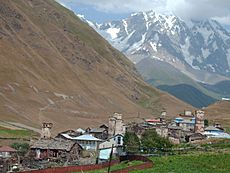Feud facts for kids
A feud (pronounced FYOOD) is a long-lasting argument or fight between groups of people. Often, these fights involve entire families or clans. In a feud, people might be seen as guilty just because they are connected to someone else who is considered guilty. This is sometimes called "guilt by association."
Feuds usually begin when one group feels they have been attacked, insulted, or harmed by another. Strong feelings of anger and a desire for revenge can start a cycle of back-and-forth violence. This cycle of attacks and counter-attacks makes it very hard to end a feud peacefully. Feuds can involve family members and friends of the original people involved, and they can even last for many generations.
Long ago, feuds were sometimes seen as a normal way to settle disagreements. Some rulers even made laws about how feuds should be carried out. But as modern governments became stronger and took control of law enforcement, feuds became illegal. This is why the word "feud" now has a negative meaning.
Contents
What is a Blood Feud or Vendetta?
A blood feud is a type of feud where the cycle of violence involves killing or seriously harming people. It starts when the relatives of someone who has been killed, wronged, or dishonored want to get vengeance. They might try to kill or punish those responsible, or even their relatives, if the original culprits cannot be found.
The word vendetta comes from Italian and means "vengeance." Historically, it referred specifically to a blood feud. Today, it can also mean any long-standing feud, even if it doesn't involve bloodshed.
The History of Vendettas
Originally, a vendetta was a blood feud between two families. Family members of a victim would seek revenge for their death by killing those responsible or their relatives. Usually, the closest male relative of the person killed would carry out the vendetta, but other family members could also join in. If the person who caused the harm had disappeared or was already dead, the revenge could extend to their other relatives.
Vendettas were common in societies where the government or police were not strong enough to enforce laws. In such places, family ties were very important, and an entire family was often held responsible for what one of its members had done. Sometimes, even different branches of the same family could end up fighting each other.
Today, vendettas have mostly disappeared in societies where law enforcement works well and criminal law punishes lawbreakers.
In ancient Homeric Greece, people thought it was normal to get personal revenge against those who wronged them. This idea of vendetta was seen as a kind of war, and it was even believed to be supported by the gods.
Ancient Hebrew tribes also believed it was a duty for individuals and families to get revenge in God's name.
During the Middle Ages, especially the feudal era, private vengeance was a common part of life.
The Celtic people, found in places like Scotland and Ireland, also had a tradition of "blood feuds" that often led to murder. Disagreements between clans could last for many generations. In the late 1800s, some long and violent conflicts in the Appalachia region of the U.S. were called feuds. The most famous of these was the Hatfield–McCoy feud. These events were often reported in newspapers, but they were not necessarily connected to the older European feuds.
In the Byzantine Empire, Chariot racing clubs, like the Blues and the Greens, were more than just sports teams. They became very powerful in military and political matters. Their rivalry often led to gang warfare and street violence. This fighting reached its peak in the Nika riots of 532 AD, where almost half of the city was burned and thousands of people died.
The Central Asian plateau, north of China, was home to many nomadic tribes like the Naimans and Mongols during Genghis Khan's youth. These tribes were often unfriendly towards each other, leading to frequent raids, revenges, and plundering.
In Japan's feudal past, the Samurai class would protect their family's or lord's honor through katakiuchi (敵討ち), or revenge killings. These killings could also involve the relatives of the person who caused the offense. While some vendettas were punished by the government, like the famous story of the 47 Ronin, others were officially allowed with specific targets.
In 1495, the right to wage feuds was officially ended in the Holy Roman Empire at the Reichstag in Worms. However, it took several more decades for this new rule to be fully accepted everywhere.
In Corsica, vendetta was a social rule that required Corsicans to kill anyone who harmed their family's honor. It is estimated that between 1683 and 1715, nearly 30,000 out of 120,000 Corsicans died because of vendettas.
The Maniots, a tough group of people from Greece, have historically been known as fearless warriors who practice blood feuds. Some of these feuds lasted for months or even years. The families involved would hide in their defensive towers and attack members of the opposing family whenever they had a chance.
The Basque Country in the Late Middle Ages suffered from intense wars between local ruling families. In Navarre, these conflicts became a violent struggle between the Agramont and Beaumont parties. In Biscay, the main warring groups were called Oinaz and Gamboa. High defensive towers built by noble families were often destroyed by fires, sometimes by royal order.

In the Caucasus region, a blood feud was seen more as a duty required by public opinion than an uncontrolled feeling. In one village in Dagestan, a blood feud between two clans lasted for almost 260 years, from the 1600s to the 1860s.
Instead of a feud, sometimes a payment called blood money (or weregild in Norse culture) was made to the family of someone who was wrongfully killed, even by accident. If these payments were not made or were refused, a blood feud would then begin.
Vendettas in Modern Times
Vendettas are still said to be practiced in some parts of France (like Corsica) and Italy (especially Sicily, Sardinia, and other areas of Southern Italy). They also occur in Crete (Greece), among Kurdish clans in Iraq and Turkey, and in northern Albania.
Other places where vendettas are reported include:
- Among Pashtuns in Afghanistan.
- Among Somali clans.
- Over land in Nigeria.
- Between rival castes in India.
- Between rival tribes in Assam, India.
- Among rival clans in China and the Philippines.
- Among Arab Bedouins and Arab tribes in the mountains of Yemen.
- Between Shiites and Sunnis in Iraq.
- In southern Ethiopia.
- Among the highland tribes of New Guinea.
- In Svaneti, Dagestan, and other mountainous areas of Georgia and Azerbaijan.
- Among Chechen teips, where people seeking revenge do not accept local law enforcement.
Vendettas often continue because local law enforcement is seen as weak or uncaring.

In Albania, blood feuds have returned to rural areas after being stopped for over 40 years by the communist government. More than 5,500 Albanian families are currently involved in blood feuds. This means over 20,000 men and boys live with the constant threat of death because of these feuds. Since 1992, at least 10,000 Albanians have been killed due to blood feuds.
A cycle of vendetta can lead to endless killings, counterattacks, and even full-scale warfare that could wipe out both families. Often, the original reason for the feud is forgotten, and the fighting continues simply because it has always been there.
In the movie The Godfather, there is a scene where Michael Corleone is hiding in Sicily. He asks, "Where are all the men?" and his bodyguard replies, "They're all dead from vendettas."
Some gang wars between organized crime groups are like modern forms of vendetta. In these cases, the criminal organization, like a Mafia "family," takes the place of blood relatives.
Images for kids
See also
 In Spanish: Faidas para niños
In Spanish: Faidas para niños


